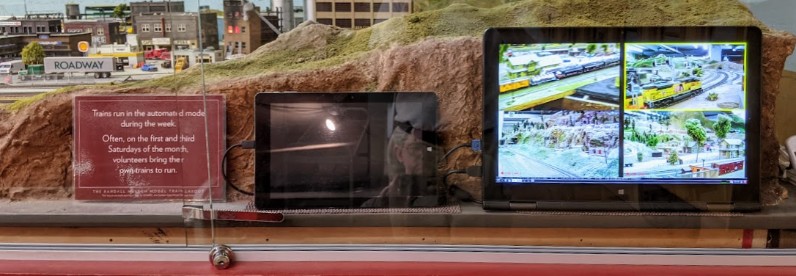The Randall Museum in San Francisco hosts a large HO-scale model model railroad. Created by the Golden Gate Model Railroad Club starting in 1961, the layout was donated to the Museum in 2015. Since then I have started automatizing trains running on the layout. I am also the model railroad maintainer. This blog describes various updates on the Randall project and I maintain a separate blog for all my electronics not directly related to Randall.
2021-09-20 - Train Vision
Category RandallThe “Train Vision” project: One part is my custom Vision software that runs on a laptop, displaying pre-recorded videos fullscreen. A second part are cameras located on the layout display live trains as they go by. When the live trains are visible, motion detection kicks in and the display changes from fullscreen to a 4-video quadrant with one view being the recorded video and the 3 other being the 3 live cameras.
I’ve spent the first half of the year reworking the Vision software from the prototype I did last year, and it’s now good enough to install it at the museum. It’s not perfect, yet we need to see it in real condition to adjust it.
The display is a 17-inch laptop. A lot of time was spent to make sure it would work as automatically as possible. It is now configured to start when the power to the layout is turned on, and it shuts off automatically with the layout power. It auto-boots Linux and my dedicated Vision program. The museum staff will not have to interact with the laptop -- no need to manually turn it on or off like they do with some other exhibits.
I quickly placed the 3 live cameras on the layout by the Fairfield passenger station. That’s temporary.
The cameras are currently working wirelessly via the layout’s dedicated wifi. I noticed the video is really choppy. I was expecting 15 fps and I’m not getting that at all. Eventually my plan is to use wire ethernet for the cameras and the laptop, which should drastically improve the framerate. However I will have to wait till I find where I want the cameras to be located before I start pulling ethernet cables.
Live camera locations are an important part to think about. I do have a number of constraints in mind:
- Should cameras view only Saturday trains, or also automated trains? My current test is going to have one camera that can see both, and the two other cameras that are focusing on Saturday train running.
- Cameras should not capture the public or the operators, as their display is motion activated. Only the live trains should trigger motion detection.
- Narrow close view of a single track or wide sweeping overall view of the layout? Probably something in between. Overall views are not that useful as I tried and found it hard to find “where’s the moving train” in the view.
- I should likely focus on parts of the layout that the public cannot really get to enjoy, because it’s partially hidden or far away. There’s no point in showing exactly what’s in front of the visitors.
- I also want the cameras to be somewhat discrete and not like ugly white plastic boxes in the middle of the scenery.
So that’s a lot of requirements, and there’s only so many suitable locations on the layout.
I already moved one camera behind the Stockton pillar. That’s an interesting location. Another location I was exploring is the top of the Summit “mountain”, however I will have to create a mount to hold it as there’s no flat surface to rest the camera there. For the last one I think some view of Lodi or the Tehachapi loop would be nice, yet from a cursory look it may be tricky to find a good spot for the cameras themselves.
Once I find the final location of the cameras, I will also likely paint them. I’ve done this on other cameras at home -- the whilte plastic is very easily painted using regular acrylic paint. A bit of blue, green, or brown goes a long way to make the camera more discrete. Another trick I had tried years ago on this layout is to modify a building and place the camera inside the building. That’s a lot more involved though.


